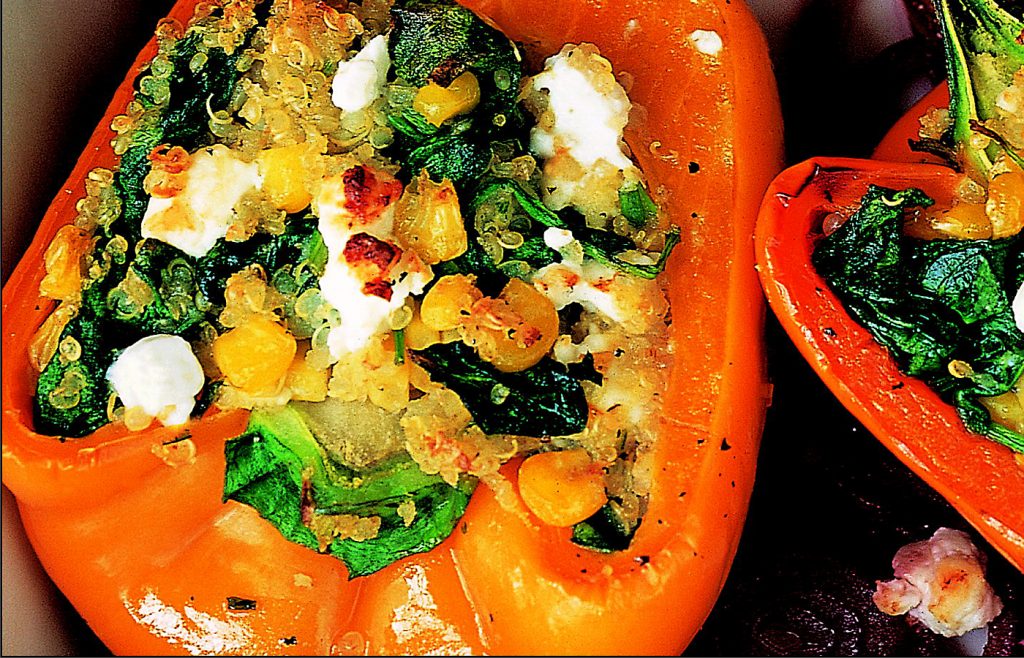
When I was a college student in Bloomington, Illinois, I rose at 3:00 a.m. one morning in 1972 to ride three hours in our food co-op’s truck to Chicago’s South Water Market. In the predawn chill I rubbed elbows with the windy city’s chefs and corner-grocery owners to choose the ripest zucchini, tomatoes, and string beans from the tailgates of farmers’ trucks.
In those years, Chicago’s wholesale food market was the closest we could get to seasonal, locally grown food, other than our own gardens. A lot has changed in the American foodscape since then. Today, more than 4,000 farmers’ markets across the country directly connect consumer to local grower.
Deborah Madison, founding chef at San Francisco’s historic Greens Restaurant, author of nine cookbooks, and winner of the Julia Child Cookbook of the Year and three James Beard awards, has been instrumental in bringing about that change. In her colorfully illustrated Local Flavors: Cooking and Eating from America’s Farmers’ Markets, newly released in paperback this May, she visits 100 farmers’ markets and provides a cornucopia of recipes based on the regional produce she discovered.
When Madison spoke at the Eco-Fair sponsored by the department of sustainable living at Maharishi University of Management in Fairfield last month, I jumped at the chance to interview her. I found her to be as vibrant and nourishing as the food she writes about.

Linda Egenes: When you cook, do you first see what’s available and then plan your menus?
Deborah Madison: Absolutely. I always cook that way, whether I’m going to the supermarket or farmers’ market or my own garden. At certain times of the year, when the farmers’ market is predictable, you know ahead of time what is available. Say in summer you want to make the perfect ratatouille, you know that this is a time for peppers, eggplant, and zucchini. So you go with a recipe in mind. Otherwise, it’s good to go to the farmers’ market with an open mind, because you never know what you’re going to see there.
In Local Flavors I talk about the seasonal vegetables I saw and how they inspired what I cooked, to perhaps encourage other people to cook in the same way. I always work from the market out.
Do eating locally and eating seasonally go hand-in-hand?
What I have learned from writing this book is a kind of a truism that “in season” is where you live. In season and local aren’t separate. They’re only separate when you go to the supermarket.
When we try to treat our foodscape as a national one, we really have painted ourselves into some strange corners and ideas about what’s in season. June magazine covers will have pictures of strawberries, for instance, but I bought strawberries in Vermont in late October last year, because there are certain kinds of ever-bearing strawberries that last until the frost. Researching Local Flavors confirmed for me that even though we often cook by clichés, when you start to look around, you see that the available local produce is very different from what your national magazine is telling you.
It seems that Local Flavors is trying to break through those clichés.
Eating local and seasonal food is something I really care about. It’s not just about the romance of farmers’ markets. We want to become intelligent about who we are and how we relate to the world around us, rather than living in this kind of predefined encapsulated vision of what’s local and what’s in season. It’s really different when you go into a farmers’ market and look around. It’s an eye opener.
Is it possible to eat strictly what is local and in season?
Yes, it’s possible but I don’t think we need to do that. Certainly people used to eat from their local region year ’round.
A book I’m reading now, Kitchen Literacy, by Ann Vileisis, is a portrait of what it takes to eat locally. It’s a different way of living and thinking. It would be hard for us because we’re used to so much variety. It would mean returning to a life where you spend a lot of time preserving food. We would have to think about how to store food over the winter, how to grow food in winter greenhouses in a way that’s not incredibly fuel intensive.
How do you see the value of organic produce versus local?
When Local Flavors came out, I did some interviews with my friend Alice Waters, and she was very purist about organics. It had to be organic or else. I was saying, “I don’t know, after what I’ve seen, I really support local.”
Since then I’ve written a few articles saying, let’s not pit them against each other. Let’s try to see how we can look at each for what they are. Obviously, oranges aren’t going to be local in Iowa, but you’re not going to stop eating oranges. In that case, let’s try to find organic oranges. And at my local farmers’ market, if I have a choice between a vendor who is selling organic versus one who is not, I’m going to choose the one who is selling organic.
In general, though, I support local producers when that’s appropriate. There’s such a difference in taste in a vegetable that’s grown locally, picked ripe, and bought fresh at your market than a vegetable that’s been grown on an industrial organic farm and shipped from California.
The following recipes are reprinted with permission from Local Flavors: Cooking and Eating from America’s Farmers’ Markets.
Yellow Wax Beans with Lemon Thyme & Yellow Tomatoes
This is a pretty dish of beans, and pretty good to eat, too.
1 pound yellow wax beans or other fresh beans, as you prefer
Sea salt
1 tablespoon unsalted butter
1 tablespoon olive oil
2 shallots, minced
1 yellow tomato, peeled, seeded, diced
2 tsp. finely chopped lemon thyme
Champagne vinegar
1. Tip, tail, then cut the beans into 3-inch lengths. Boil them in plenty of salted water, uncovered, until tender firm, about 5 minutes. Taste to make sure, though. Beans can take a while, depending on their size.
2. While they’re cooking, melt the butter with the olive oil, add the shallots, and cook over medium heat for 2 minutes, then add the tomato and thyme.
3. Drain the beans as soon as they’re done, add them to the pan, and cook briefly, coating them with the sauce. Season with a few drops of vinegar and serve.
White Beans with Black Kale and Savoy Cabbage
If you add water or stock, you can make this into a hearty minestrone to serve with garlic-rubbed toast. One day I decided to stop before adding the liquid and just enjoyed the two greens entwined with the beans. You can still serve it over toast for a hearty bruschetta, over pasta, or as a side to a roast chicken.
1 cup dried cannellini, navy beans, or gigantes, soaked for 4 hours or overnight
Sea salt and freshly ground pepper
1 large onion, finely diced
2 leeks, white parts only, diced
1 bunch black kale, the leaves stripped from the stems and slivered
1 small Savoy cabbage, quartered, cored, and chopped
2 plump garlic cloves, minced or pounded with a pinch of salt
1/2 cup chopped parsley
2 tablespoons olive oil, plus extra to finish
1. Drain the soaked beans, then put them in a pot and cover with cold water. Bring to a boil, add 1/2 teaspoon salt, then lower the heat and simmer, partially covered, until the beans are tender, about 1-1/2 hours.
2. While the beans are cooking, chop all the vegetables. Rinse the leeks, kale, and cabbage, but don’t dry them.
3. Warm 2 tablespoons of the oil in a heavy wide skillet. Add the onion and leeks and cook over medium-low heat until the onion is soft but not browned, about 12 minutes. Add the kale, cabbage, garlic, parsley, and 2 teaspoons salt. Cook with the heat on low and the pan covered until the vegetables are soft and the volume greatly reduced, about 30 minutes.
4. When the beans are done, add them, along with a cup or two of their cooking liquid, to the pot. Simmer until the greens are completely tender. Taste for salt and season with pepper. Serve with, or over, garlic-rubbed toast, drizzled with olive oil.
Linda Egenes is a Fairfield freelance writer who buys local whenever she can.
